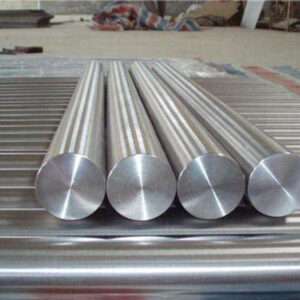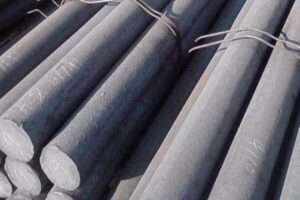Einführung
In the vast world of materials, alloy round bars hold a prominent place due to their diverse properties and applications. Among these alloys, 1045 steel stands out as a versatile and widely used option. This comprehensive exploration delves into the intricacies of how 1045 steel compares to other alloy round bars, unraveling the distinct characteristics that shape their roles in engineering and industry.
Alloy Round Bars: A Multifaceted Landscape
 Alloy round bars encompass a diverse array of materials, each designed to offer a unique set of properties. From enhanced strength and durability to improved corrosion resistance and thermal conductivity, these alloys cater to a wide spectrum of applications across industries.
Alloy round bars encompass a diverse array of materials, each designed to offer a unique set of properties. From enhanced strength and durability to improved corrosion resistance and thermal conductivity, these alloys cater to a wide spectrum of applications across industries.
Unveiling 1045 Stahl: Zusammensetzung und Eigenschaften
1045 steel, a medium-carbon steel alloy, boasts a composition comprising around 0.45% carbon and moderate amounts of manganese. This balance endows 1045 steel with a combination of strength, ductility, and machinability, making it suitable for various applications that demand a harmonious blend of properties.
Comparing 1045 Steel with High-Carbon Steel
3.1 Strength and Ductility
Compared to high-carbon steels, 1045 steel strikes a balance between strength and ductility. While high-carbon steels offer higher hardness and strength, they often sacrifice ductility, which can lead to brittleness. 1045 steel maintains a degree of ductility while still providing impressive tensile strength, making it favorable for components that require both robustness and resistance to fracture.
3.2 Machinability and Weldability
In terms of machinability and weldability, 1045 steel outperforms high-carbon steels. High-carbon steels can be challenging to machine and weld due to their increased hardness. 1045 steel’s moderate carbon content facilitates machining and welding processes, contributing to ease of fabrication.
1045 Steel vs. Stainless Steel Round Bars
4.1 Corrosion Resistance
Stainless steel round bars excel in corrosion resistance, a property not inherent in 1045 steel. While stainless steel is ideal for applications requiring exposure to corrosive environments, 1045 steel might require additional coatings or treatments to mitigate corrosion.
4.2 Mechanical Properties
Mechanically, 1045 steel offers a balance of properties that is distinct from stainless steel. While stainless steel can provide varying degrees of tensile strength and hardness, 1045 steel excels in strength-to-weight ratio and wear resistance. The choice between these materials depends on the specific requirements of the application.
1045 Steel and Alloy Tool Steel Round Bars
5.1 Hardness and Wear Resistance
Alloy tool steel round bars, designed for exceptional hardness and wear resistance, have distinct advantages in applications involving cutting, shaping, and forming. 1045 steel, while not as hard as alloy tool steel, still offers commendable wear resistance, making it suitable for components subjected to moderate wear and stress.
5.2 Applications and Versatility
The applications of alloy tool steel round bars often revolve around toolmaking and precision machining. 1045 steel, on the other hand, finds its place in a broader spectrum of applications, spanning automotive components, machinery, and construction equipment. Its versatility and balanced properties contribute to its widespread use.
Comparative Analysis with Alloy Aluminum Round Bars
 6.1 Density and Weight
6.1 Density and Weight
Compared to alloy aluminum round bars, 1045 steel round bars have higher density and weight. Aluminum’s low density makes it ideal for applications that demand lightweight materials, while 1045 steel’s denser nature contributes to its mechanical strength and durability.
6.2 Conductivity and Thermal Properties
Aluminum’s exceptional thermal conductivity sets it apart from 1045 steel. Alloy aluminum round bars are often chosen for applications requiring efficient heat dissipation, such as in the electronics industry. 1045 steel, while not as thermally conductive, excels in mechanical properties and strength.
Impact of Cost and Availability
The cost and availability of materials play a pivotal role in material selection. While the cost of 1045 steel round bars is generally lower than that of certain high-performance alloys like alloy tool steels, it’s essential to consider the balance between performance and budget when choosing between materials.
FAQ about Comparing 1045 Stahl with Other Alloy Round Bars
Q1: Can 1045 steel round bars replace high-carbon steel in all applications?
While 1045 steel offers improved machinability and weldability compared to high-carbon steel, the choice between the two depends on specific mechanical requirements. Applications that demand higher hardness and strength may still favor high-carbon steel.
Q2: Which material is better for applications involving corrosive environments: 1045 steel or stainless steel?
Stainless steel is the superior choice for applications in corrosive environments due to its inherent corrosion resistance. 1045 steel might require additional protective measures to prevent corrosion.
Q3: How does the wear resistance of 1045 steel compare to alloy tool steel?
Alloy tool steel offers superior hardness and wear resistance compared to 1045 steel. For applications requiring exceptional wear resistance, alloy tool steel might be a more suitable choice.
Q4: What factors should be considered when choosing between 1045 steel and aluminum alloys?
Consider the mechanical requirements, weight considerations, thermal properties, and cost when choosing between 1045 steel and aluminum alloys. Each material has its strengths and is better suited for specific applications.
Q5: Does 1045 Stahl have better machinability than alloy tool steel?
Yes, 1045 steel generally has better machinability compared to many alloy tool steels. The moderate carbon content of 1045 steel contributes to its improved machinability and ease of fabrication.
Schlussfolgerung
The comparison between 1045 steel and other alloy round bars transcends numerical values, encompassing a rich tapestry of properties and applications. Each material holds its unique place in the world of engineering, contributing to the creation of structures, machinery, and innovations that shape our modern landscape. The choice between these alloys hinges on a deep understanding of their attributes and how they align with the demands of each specific application.
